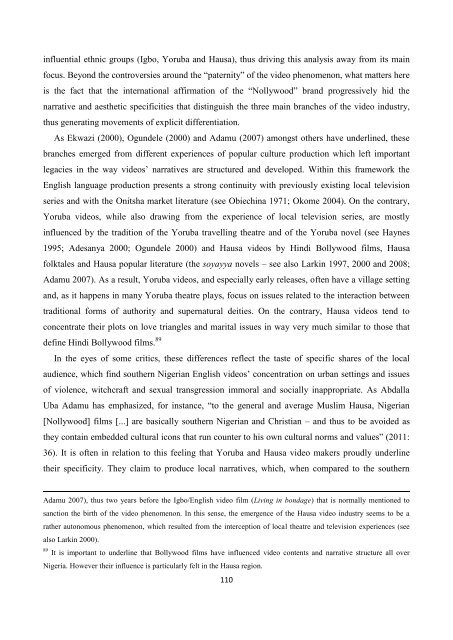Create successful ePaper yourself
Turn your PDF publications into a flip-book with our unique Google optimized e-Paper software.
influential ethnic groups (Igbo, Yoruba and Hausa), thus driving this analysis away from its mainfocus. Beyond the controversies around the “paternity” of the video phenomenon, what matters hereis the fact that the international affirmation of the “Nollywood” brand progressively hid thenarrative and aesthetic specificities that distinguish the three main branches of the video industry,thus generating movements of explicit differentiation.As Ekwazi (2000), Ogundele (2000) and Adamu (2007) amongst others have underlined, thesebranches emerged from different experiences of popular culture production which left importantlegacies in the way videos’ narratives are structured and developed. Within this framework theEnglish language production presents a strong continuity with previously existing local televisionseries and with the Onitsha market literature (see Obiechina 1971; Okome 2004). On the contrary,Yoruba videos, while also drawing from the experience of local television series, are mostlyinfluenced by the tradition of the Yoruba travelling theatre and of the Yoruba novel (see Haynes1995; Adesanya 2000; Ogundele 2000) and Hausa videos by Hindi Bollywood films, Hausafolktales and Hausa popular literature (the soyayya novels – see also Larkin 1997, 2000 and 2008;Adamu 2007). As a result, Yoruba videos, and especially early releases, often have a village settingand, as it happens in many Yoruba theatre plays, focus on issues related to the interaction betweentraditional forms of authority and supernatural deities. On the contrary, Hausa videos tend toconcentrate their plots on love triangles and marital issues in way very much similar to those thatdefine Hindi Bollywood films. 89In the eyes of some critics, these differences reflect the taste of specific shares of the localaudience, which find southern Nigerian English videos’ concentration on urban settings and issuesof violence, witchcraft and sexual transgression immoral and socially inappropriate. As AbdallaUba Adamu has emphasized, for instance, “to the general and average Muslim Hausa, Nigerian[Nollywood] films [...] are basically southern Nigerian and Christian – and thus to be avoided asthey contain embedded cultural icons that run counter to his own cultural norms and values” (2011:36). It is often in relation to this feeling that Yoruba and Hausa video makers proudly underlinetheir specificity. They claim to produce local narratives, which, when compared to the southernAdamu 2007), thus two years before the Igbo/English video film (Living in bondage) that is normally mentioned tosanction the birth of the video phenomenon. In this sense, the emergence of the Hausa video industry seems to be arather autonomous phenomenon, which resulted from the interception of local theatre and television experiences (seealso Larkin 2000).89 It is important to underline that Bollywood films have influenced video contents and narrative structure all overNigeria. However their influence is particularly felt in the Hausa region.110
















